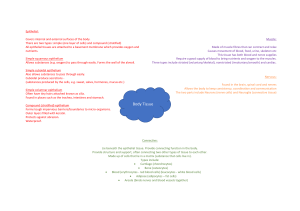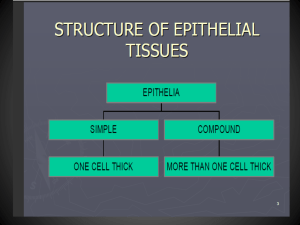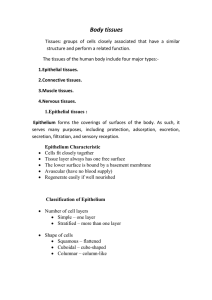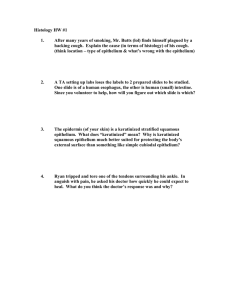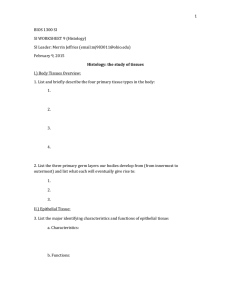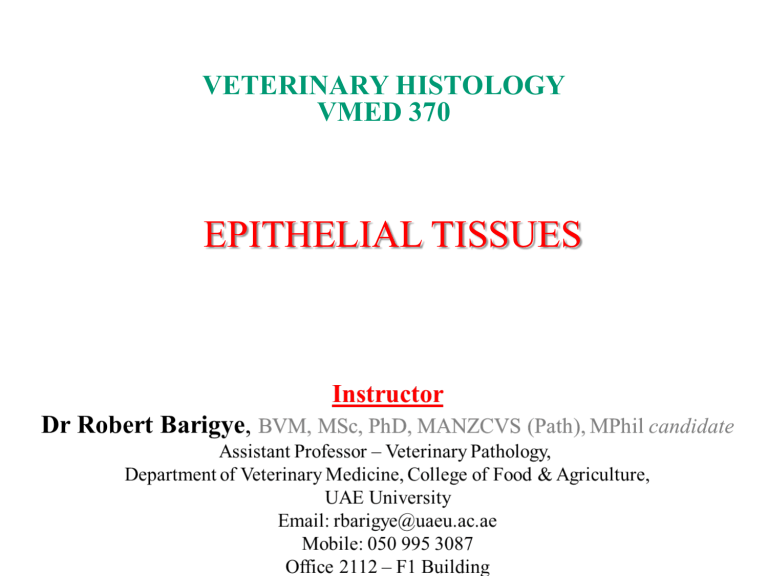
VETERINARY HISTOLOGY VMED 370 EPITHELIAL TISSUES • There are (4) types of tissue: GENERAL CHARACTERISTICS OF EPITHELIUM: Epithelial tissues are anchored to (sit on) a basement membrane, They are made up of tightly packed cells connected by intercellular junctions They are avascular -- generally lack blood vessels Regenerate – in case they are damaged – meaning they are easily replaced. All epithelial tissue sits on a basement membrane Basement membrane: a thin extracellular supporting layer that separates a layer of epithelial cells from the underlying lam ina propria. It is composed of the basal lamina and reticular lamina is composed of Type IV collagen, laminin, fibronectin, and proteoglycans such as heparan sulfate. nucleus Through intercellular junctions, cells come together to form tissues LOCATION Lining of body cavities and surfaces of visceral organs – mesothelium Lining of digestive tract, respiratory, urinary tract, reproductive tract etc Lining of heart, lymphatic vessels, and blood vessels – endothelium Lining of glands (endocrine + exocrine) and exocrine gland ducts Lining of the skin – epidermis FUNCTION OF EPITHELIUM • Protection – infection, toxic chemicals, UV radiation (skin) • Absorption – absorption of nutrients nourishes cells and tissues; maintain homeastasis • Secretions – hormones, mucus, enzymes Classification of epithelial tissues: Based on SHAPE: • Squamous epithelium – thin, “flattened” • Cuboidal epithelium – cubed shape • Columnar epithelium – rectangular -- think “column” Based on SHAPE: Squamous Cuboidal Columnar How epithelial tissues are classified: Based on number of cell LAYERS: Simple epithelium = single layer Stratified epithelium = more than one layer Pseudostratified epithelium = one layer but looks as if it has many layers Simple epithelium Pseudostratified BM One layer of cells One layer of cells Cells not the same height Stratified epithelium Basal surface Two or more layer of cells BM Types of epithelium • Simple squamous • Stratified squamous • Simple cuboidal • Stratified cuboidal • Simple columnar • Stratified columnar • Pseudostratified Simple Squamous Epithelium Simple squamous epithelium is made up of a single layer of thin, flattened cells. Because it is suited for diffusion, it has functions in the exchange of gases in the lungs and lines blood and lymph vessels as well as body cavities. Figure 4.3a Epithelial tissues. SIMPLE SQUAMOUS EPITHELIUM (a) Simple squamous epithelium Description: Single layer of flattened cells with disc-shaped central nuclei and sparse cytoplasm; the simplest of the epithelia. Air sacs of lung tissue Function: Allows passage of materials by diffusion and filtration in sites where protection is not important; secretes lubricating substances in serosae. Nuclei of squamous epithelial cells Location: Kidney glomeruli; air sacs of lungs; lining of heart, blood vessels, and lymphatic vessels; lining of ventral body cavity (serosae). Photomicrograph: Simple squamous epithelium forming part of the alveolar (air sac) walls (125x). The Bowman’s capsule in the kidney is lined by a squamous epithelium. Note that the proximal and distal convoluted tubules are instead lined by a simple cuboidal epithelium. Endothelial cells are specialized squamous epithelial cells that line the lumen of blood vessels, lymphatic vessels and heart LYMPHATIC VESSEL BLOOD CAPILLARY On the surface of most thoracic and abdominal organs (eg lung, liver, spleen), there is a specialized type of epithelium called mesothelium. Mesothelium on the visceral pleura Alveolar space Alveolar space A specialized type of simple squamous epithelium is found lining the body cavities and the surfaces of most visceral organs eg. Lung, liver, spleen SIMPLE CUBOIDAL EPITHELIUM Simple cuboidal epithelium consists of a single layer of cube-shaped cells with centrally located nuclei. It functions in absorption eg. in the proximal convoluted tubules of the kidneys It functions in secretion eg. in glands – Endocrine glands eg thyroid gland; Exocrine glands eg exocrine pancreas. Figure 4.3b Epithelial tissues. SIMPLE CUBOIDAL EPITHELIUM (b) Simple cuboidal epithelium Description: Single layer of cubelike cells with large, spherical central nuclei. Simple cuboidal epithelial cells Function: Secretion and absorption. Basement membrane Location: Kidney tubules; ducts and secretory portions of small glands; ovary surface. Connective tissue Photomicrograph: Simple cuboidal epithelium in kidney tubules (430x). u CopyrightThe McGraw-Hill Companies, Inc. Permission required for reproduction or display. Simple Cuboidal Simple cuboidal epithelium found in renal tubules Simple cuboidal epithelium lining the surface of the ovary Simple cuboidal epithelium on the front surface of the eye lens Stratified cuboidal epithelial tissues are more rare comparing to other epithelial types. This picture was taken from salivary gland duct showed that the inner most layer, or right around the lumen, contains cuboidal cells but the rest of the layers may or may not be cuboidal in shape. https://kitng.me/2016/08/03/stratified-cuboidal-epithelium/ Stratified cuboidal epithelium is rare and only found in some glands and their ducts u CopyrightThe McGraw-Hill Companies, Inc. Permission required for reproduction or display. SIMPLE COLUMNAR EPITHELIUM Made up of a row of elongated cells whose nuclei are all located near the basement membrane. It may be ciliated or bear microvilli. It lines the uterus, stomach, and intestines where it protects underlying tissues, secretes digestive fluids, and absorbs nutrients. In the intestine, these cells possess microvilli that increase the surface area available for absorption. Mucus-secreting goblet cells can be found among columnar cells. Figure 4.3c Epithelial tissues. SIMPLE COLUMNAR EPITHELIUM (c) Simple columnar epithelium Description: Single layer of tall cells with round to oval nuclei; some cells bear cilia; layer may contain mucussecreting unicellular glands (goblet cells). Simple columnar epithelial cell Function: Absorption; secretion of mucus, enzymes, and other substances; ciliated type propels mucus (or reproductive cells) by ciliary action. Location: Nonciliated type lines most of the digestive tract (stomach to anal canal), gallbladder, and excretory ducts of some glands; ciliated variety lines small bronchi, uterine tubes, and some regions of the uterus. Basement membrane Photomicrograph: Simple columnar epithelium of the stomach mucosa (860X). Simple columnar epithelium Alcian blue stain H&E Simple columnar epithelium lining the surface of the simple stomach The gall bladder is also lined by a simple columnar epithelium u CopyrightThe McGraw-Hill Companies, Inc. Permission required for reproduction or display. STRATIFIED SQUAMOUS EPITHELIUM This type of epithelial tissue is made up of layers of flattened cells that are designed to protect underlying tissues. It makes up the outer layer lining the: – Epidermis of the skin; hooves – Oral cavity (mouth), – Oesophagus – Vagina, and anal canal – Rumen, reticulum, omasum (ruminant stomach) Keratin layer Epidermis Dermis In the skin, the keratinized squamous epithelium covers body surfaces thus providing protection In the skin, the keratinized squamous epithelium covers body surfaces thus providing protection In the oesophagus, a nonkeratinized stratified squamous epithelium covers the surface and protects the underlying tissues from noxious insults. Note that the cells in the outer layers of the oesophagus lack keratin. The epithelium may undergo keratinization in case of some disease conditions u CopyrightThe McGraw-Hill Companies, Inc. Permission required for reproduction or display. Keratinized squamous epithelium like that seen in the skin and hooves of animals is quite effective in protecting underlying tissue especially in areas exposed to the body surface HOOF SKIN keratin u CopyrightThe McGraw-Hill Companies, Inc. Permission required for reproduction or display. F. Stratified Cuboidal Epithelium 1. This tissue consists of two to three layers of cuboidal cells lining a lumen of the ducts of mammary glands, sweat glands, salivary glands, pancreas. 2. Several layers of cells provide greater protection than one single layer. u CopyrightThe McGraw-Hill Companies, Inc. Permission required for reproduction or display. STRATIFIED CUBOIDAL Stratified Epithelium 3. Stratified Cuboidal – Ducts of sweat glands -- this type + stratified columnar are rare! u CopyrightThe McGraw-Hill Companies, Inc. Permission required for reproduction or display. PSEUDOSTRATIFIED COLUMNAR EPITHELIUM 1. These cells appear layered due to the varying positions of their nuclei within the row of cells, but in actual fact the cells are not truly layered. 2. Cilia may be present, along with mucus-secreting goblet cells, that line and sweep debris from respiratory tubes. Figure 4.3d Epithelial tissues. PSEUDOSTRATIFIED EPITHELIUM (d) Pseudostratified columnar epithelium Description: Single layer of cells of differing heights, some not reaching the free surface; nuclei seen at different levels; may contain mucussecreting cells and bear cilia. Cilia Mucus of mucous cell Pseudostratified epithelial layer Function: Secretion, particularly of mucus; propulsion of mucus by ciliary action. Location: Nonciliated type in male’s sperm-carrying ducts and ducts of large glands; ciliated variety lines the trachea, most of the upper respiratory tract. Trachea Photomicrograph: Pseudostratified ciliated columnar epithelium lining the human trachea (570x). Basement membrane Pseudostratified epithelium in the bronchus. This is seen in the respiratory epithelium of the nasal cavity, and trachea as well. Pseudostratified epithelium is also seen in the epididymis. It has long cilia called stereocilia u I. CopyrightThe McGraw-Hill Companies, Inc. Permission required for reproduction or display. TRANSITIONAL EPITHELIUM 1. Transitional epithelium is designed to distend and return to its normal size, as it does in the lining of the urinary bladder. 2. This design provides distensibility and keeps urine from diffusing back into the internal cavity. Also found in renal pelvis, ureter, proximal parts of urethra Transitional epithelium Transitional epithelium In addition to protection, the transitional epithelium found in the urinary bladder, ureter, and renal pelvis can stretch and accomondate increasing amounts of urine. CELL SURFACE MODIFICATIONS Microvilli – short fingerlike projections of the cell membrane that increase surface area for absorption Cilia– projections of the cell membrane composed of microtubules (9 +1 pairs pattern) Common in the respiratory tract – adopted to move particles trapped in mucus Stereocilia – long microvilli found in the epididymis and ear
